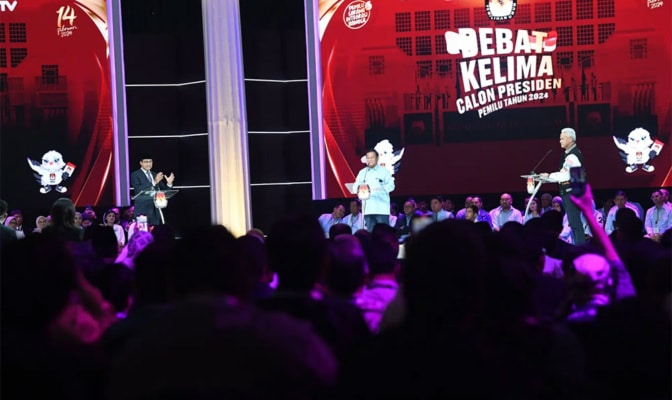Unravelling the contrasts in voter preferences for presidential candidates on social media
Share on LinkedIn
Users on X are equipped with the knowledge of past histories, government experiences, political outlook, and future policies from each candidate.
The presidential elections have been a captivating spectacle over the past decade, characterized by their uniqueness due to the country’s diverse background and a population exceeding 250 million.
This year young voters, comprising both millennials and Gen Z, make up 52 percent of the total national electorate.
As the election campaign unfolds, candidates are once again resorting to unconventional tactics to secure the support of the ever-growing younger voting bloc.
Recognizing Gen Z as swing voters, the candidates are employing catchy strategies to capture their attention, especially through online platforms.
The three presidential tickets are leaving no stone unturned in their efforts to attract the attention of young voters. As TikTok, Instagram and X (formerly Twitter) are some of the biggest platforms utilized by the younger generation in Indonesia, each candidate employs unique strategies. Looking closer into the social media landscape, each of the platforms has different characteristics for their audiences. Furthermore, each candidate also has their own ways of utilizing their platforms, especially through various kinds of gimmicks.
The candidate pair Anies Baswedan and Muhaimin Iskandar, went live on TikTok giving inspirational speeches and portraying the role of father figures. The campaign team has also initiated “Desak Anies” (Urge Anies), a campaign event where anyone can ask Anies anything, even if the questions are controversial. The event footage has been shared widely on social media showcasing how Anies can bring a platform and give answers to any citizen as a leader.
The candidate pair of Prabowo Subianto and Gibran Rakabuming Raka has implemented various strategies, primarily on TikTok and Instagram. These include dance performances known as gemoy incorporating artificial intelligence (AI)-generated photos, videos and more. Additionally, the campaign team has utilized platform X, through @Gerindra (Prabowo’s political party), to personally engage with users, further diversifying their outreach efforts.
The candidate pair of Ganjar Pranowo and Mahfud MD places a significant emphasis on their presence on platform X. In particular, Ganjar, renowned for his straightforward approach, personally engages with the audience using casual language.
From these observations, TikTok and Instagram, known for their visual content-based platform, have become battlegrounds for candidates to showcase their lighter sides, which is appealing to the young generation in some groups. Many young people participate with enthusiasm and the gimmicks appear to sway their preferences for the candidates.
Have those gimmicks on social media worked in gaining a number of voters?
Referring to 15 recent surveys officially registered by the General Elections Commission (KPU), the results indicate that Prabowo-Gibran could win the election. An interesting finding from Indikator Politik Indonesia research held in October 2023 found 52.4 percent of Gen Z and 40 percent of millennial voters will vote for Prabowo-Gibran. However, the surveys cannot be determined as the final result.
The candidacy of Prabowo-Gibran is also backed by the Indonesia Solidarity Party (PSI), a political party renowned for its predominantly youthful and millennial membership. With his popularity in the digital world, these days we see how Gen Z romanticize the presence of Prabowo on its digital platforms. Overall, the campaigns work for certain groups regardless of the substance within them.
The story turns on X where these gimmicks have not been without criticism. Due to the platform’s focus on written content, its users tend to share opinions and well-rounded thoughts on knowledge and personal growth. The user base on X often seeks intellectual stimulation, diverging from the visual-centric nature of platforms like TikTok and Instagram.
With these characteristics, users on X are equipped with the knowledge of past histories, government experiences, political outlook and future policies from each candidate. They have critical thinking skills where they can analyze the information to shape their political preferences.
Many individuals, including members of the younger generation, have expressed their discontent on X with the gimmicks on Instagram or TikTok. Some even argue that the visual gimmicks are over the top and may detract from the serious issues that should be at the forefront of political discourse.
There has been a growing wave on the platform with people actively participating in movements against Prabowo-Gibran, candidate pair number two. Numerous celebrities and influencers are opposing them, using the hashtag #Asa1Bukan02 (anyone but No. 2). Recently, there has been a movement “Salam 4 Jari” (Four-Finger Salute) on X, allegedly proposing to encourage people not to choose Prabowo-Gibran.
Nevertheless, it remains uncertain whether the criticism on X will translate into a significant impact on the election outcome. The dynamics of social media influence are multifaceted, and a single platform’s critique may not be the sole determinant of voter behavior. Similarly, survey results, while informative, cannot be solely relied upon as the main indicator of electoral success. The interplay of various factors in the digital and offline spheres contributes to the complexity of understanding voter sentiment and predicting electoral outcomes.
The diversity in platforms reveals the complex interplay between visual appeal and intellectual engagement within the realm of political discourse. As the campaign progresses, the contrasting preferences of voters, especially among the younger demographic, continue to shape the narrative of the presidential race.
The contrasting preferences on TikTok, Instagram and X underscore the importance of understanding the diverse nature of online communities. While visuals may capture the hearts of Gen Z on one platform, well-articulated arguments on another may shape the opinions of a more critical audience.
The intersection of social media, politics and generational differences continues to evolve, shaping the landscape of Indonesian democracy in unprecedented ways. The challenge for candidates lies in finding the delicate balance that resonates with the diverse electorate, ensuring that their messages are not only seen but also understood in a meaningful and impactful way.
Written in The Jakarta Post.
H/Advisors Klareco


